Last Updated on May 4, 2022
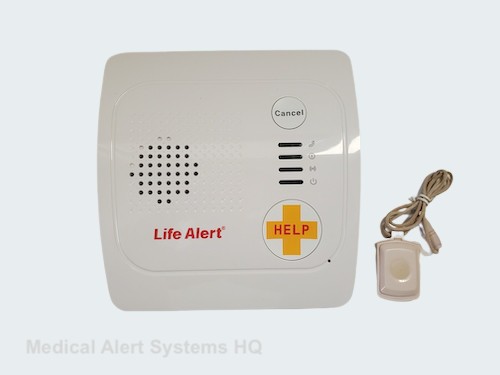
Life Alert popularized the idea of home medical alert systems for seniors through their “I’ve fallen and I can’t get up!” TV ads. With such a well-known brand name, does it make them a good choice? We will cover both the advantages and disadvantages of Life Alert in this review, so you can make an informed choice.
In a hurry? Leave us your email, we’ll follow-up with the best tips.
Background
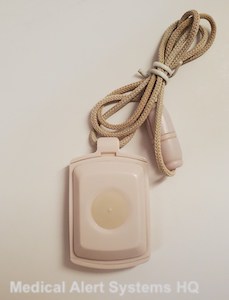
Life Alert is one of the largest medical alert systems companies in the US. The company was founded in 1987. Over time, it has expanded to 8 offices spread across the country in California, New Jersey, New York and Florida. Their headquarters is in Encino, CA (greater Los Angeles area).
The Life Alert name is very well-known amongst seniors, in no small way due to their successful advertising campaigns over the last three decades. Their ad slogan “I’ve fallen and I can’t get up!” is an advertising classic, inspiring interest and hope amongst seniors and their loved ones. Their brand is so well-known that medical alert systems in general have been called “life alert” systems.
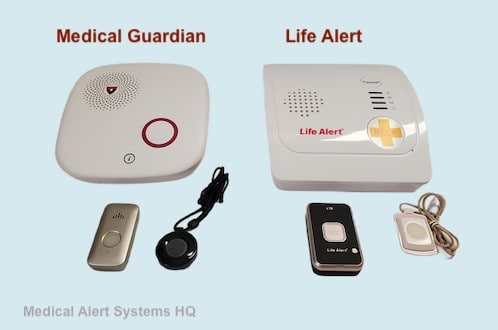
Many seniors and their families choose Life Alert because it is the top-of-mind brand for them. In the past decade, however, newer competitors with quality services have made significant in-roads into the medical alert systems industry, giving Life Alert stiff competition. In this review, we will also compare the similarities and differences of Life Alert vs other medical alert companies.
According to their website, Life Alert’s monitoring service handles over two million calls a year and employs a staff of over 600, all in the US. Life Alert’s products support the elderly, and other customers in living independently at home with a sense of security and peace. Their company was endorsed by the late Everett Koop, former U.S. Surgeon General.
Pros
In-Home and On-the-go – Beyond Life Alert’s traditional in-home necklace button, they also offer an on-the-go mobile GPS help pendant.
No home phone line needed – Their equipment is suitable for homes with or without home phone lines. They have an in-home cellular base console unit.
Operates own monitoring center – Life Alert owns and operates its own UL and TMA 5-Diamond certified call monitoring center. This allows the company to manage how emergency response calls are being handled more directly. We lack information about their backup monitoring process, though.
Batteries do not need changing – All their medical alert button devices have up to 6 to 10 years of battery life, including their mobile Help pendant. Buttons do not need any recharging. This makes medical alert system use simpler for seniors and other customers.
In-person installation – Life Alert offers in-person installations when possible. Although installing a medical alert system is really simple, having in-person help can make it easier for some customers. This service is included in their $95 to $198 start-up fee.
Cons
3-year contract – Life Alert requires a 3-year contract commitment, while most companies do not require any term contracts. Despite the long contract, there is no 30-day trial to let customers try and decide.
Higher prices – Their monthly fees tend to be higher than the industry average, and they charge an additional start-up fee of $95 to $198.
No location sharing – Life Alert’s mobile GPS button does not have any text-to-locate or location sharing mobile app features. If Mom or Dad is out unusually long and we can’t reach them by phone, having this location information would be useful.
No fall detection option – Life Alert does not offer fall detector pendants as an option, which most top-tier medical alert companies offer.
Life Alert Systems and Pricing
Life Alert offers their in-home Signature Service for an entry-level price of $49.95 per month. With additional options such as on-the-go monitoring and a shower button, the total Life Alert package price adds up to $69.90 to $89.95 a month. This pricing includes the use of Life Alert help buttons and all equipment. There is a one-time start-up fee of $95 to $198 that covers processing, programming, shipping, installation, and equipment maintenance.
In-Home Life Alert System – Signature Service
An in-home Master Unit (base console unit) that contains speaker and microphone, and separate transmitter necklace or bracelet button.
- Connectivity: Landline or Cellular LTE (no phone line needed)
- Cellular network: GSM (AT&T)
- Fall Detection Button: Not Available
- Price: $49.95/mo, either landline or cellular
- Initial start-up fee: $95
Signature Service with Shower Button or Mobile Help Button LTE GPS
Customers add on either one or both options below to complete their package:
- Shower button
- Mobile Help pendant LTE with GPS
Signature Service and ONE add-on
Package Price: $69.90/mo total
Package start-up fee: $197 total one-time
Signature Service and BOTH add-ons
Package Price: $89.95/mo total
Package start-up fee: $198 total one-time
In-Home System Design and Features
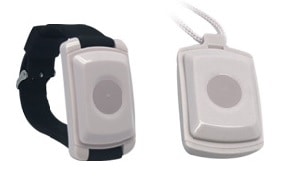
Central to a Life Alert subscription is their in-home medical alert base unit, which Life Alert terms their Master Unit. This is an emergency call dialer and speakerphone device that is paired with a separate necklace or bracelet help transmitter button.
When an emergency happens, the subscriber can press their transmitter button to send a signal to the base unit. The button-press works like a remote control to signal the base unit to dial into Life Alert’s 24/7 emergency response monitoring center.
The base unit or Master Unit houses a speaker and microphone to facilitate a two-way conversation between the subscriber and Life Alert emergency response dispatcher.
A Life Alert dispatcher will answer the emergency call and speak with the subscriber through the base unit. Based on the situation, the dispatcher will contact emergency services and family members as needed.
Original Cellular Base Unit
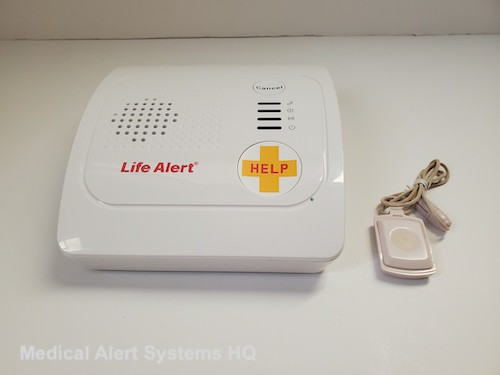
What if you or your parents no longer have a home phone line? The in-home Life Alert system will still work through their cellular Master Unit. The company will provide a base console unit, the Help Pers LTE 919, that connects via a GSM network like AT&T.
The Life Alert Help Pers unit has been specially developed in-house to work with Life Alert’s processes and requirements. It’s available only to Life Alert customers. This unit is quality equipment that conforms to industry UL standards.
We like the obvious Cancel button at the front that makes it easy to cancel out mistaken button presses. We also like how their front indicator lights will flash when there could be issues with the system. These flashing lights act as a prompt for customers to preemptively contact Life Alert for help.
Testing
The company advises customers to perform regular test calls using their buttons. Customers can push their help alert button to make sure that they can connect to the call center. We also recommend periodically checking with the dispatcher to ensure they have your correct home address and key emergency contacts information.
Some medical alert systems companies send automated test signals in the background to check that the base unit is plugged into power, as an added precaution. According to Life Alert’s representatives we spoke with, this is not part of their process. Their cellular base unit has lights that will flash to indicate potential problems.
Regardless of whether automated test signals are being sent, medical alert customers are well-advised to make regular test calls and contact the company if any error lights come on.
Backup Power
Fortunately, according to specifications, both their landline or cellular base units come with a three-day or 72-hour backup battery. If there is a power outage or a temporary disconnection from power, the backup battery will continue to power the system for a little longer.
In-Home System Subscription Requirement
No matter which Life Alert subscription you sign up for, their in-home system base unit will be part of your Life Alert package.
In contrast, almost all medical alert system companies would allow customers to subscribe to a standalone cellular all-in-one pendant without requiring an in-home base unit to be included. The all-in-one button is a much smaller wearable base unit alternative that works both in and out of the home.
One Life Alert customer mentioned that the multiple devices made usage more confusing. We believe there are pros and cons to this approach. True, using one single medical alert device is simpler. However, when you have double in-home, out-of-home coverage, it ensures greater reliability.
For alternatives, we suggest comparing Life Alert with Bay Alarm Medical. Bay Alarm Medical offers either their in-home and on-the-go systems separately and as one combination bundle like Life Alert.
Range Considerations for In-Home System
According to Life Alert, their in-home transmitter button has a maximum range of up to 800 feet. That means that from a distance as far away as 800 feet, the transmitter button may still be able to signal the base unit to start an emergency call. This is a long distance – more than twice the length of a full football field (360 ft).
However, the actual working range will be affected by obstacles present (eg. wall materials) that could create interference.
If are using the cellular base unit, another factor to consider is whether the cellular signals are strong enough for emergency calls to go through to the monitoring center.
Given that the impact of both the above factors, it makes sense to test out your system periodically as advised. When testing the system, consider pushing the button from different home areas, especially in high-risk areas and the outskirts furthest away from where the base unit is placed.
Note that while the transmitter button is able to remotely send calls through the base unit from far, voice communication may be difficult if you are really far from the Unit. A voice extension device like Life Alert’s shower button or mobile help pendant would be helpful for facilitating two-way conversations.
Shower Button LTE Extends Voice Communication Range
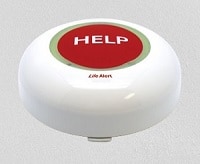
The Life Alert shower help LTE button is a large, round, waterproof wall button that you can stick to the walls near the shower or bath-tub.
It is a standalone device that comes with its own cellular connection, speaker and microphone. When you push on the help button, it will dial into Life Alert’s dispatch center and you can speak to the dispatcher through the button itself.
We like the button’s speakerphone function as it offers real practical value during shower emergencies. Essentially, it acts as a voice extension. If you are in the shower, it may be hard to speak through the base console unit in another room. But with this shower button, you can easily speak with the operator directly.
There are similar looking shower buttons elsewhere, but this help button’s LTE speakerphone feature is specific to Life Alert; you won’t find this anywhere else.
You can place it in the bathroom or another suitable location (eg. hallway, stairs). It’s easy to install too; you can peel and stick it on walls, there’s no screws or drilling needed. Since it works through a cellular network, there are no wired connections of any sort. The batteries will last for up to 10 long years.
Compared to other Shower Buttons
While most medical alert systems companies offer a similar-looking shower Help button accessory, we don’t know of any other model that has a speaker and microphone. Shower buttons by other companies will only remotely activate an alert call through the base unit (which contains the speakerphone).
One good thing about these no-speaker shower buttons by their competitors is that they are much less costly to subscribe to (eg. $3 vs. $20 per month). It allows you to place more buttons around the home for the same cost; such as near the stairs and other high-risk fall areas.
Life Alert Mobile Help Pendant with GPS
The Life Alert mobile help pendant is a small mobile HELP button device that will connect subscribers to emergency response operators. The pendant features LTE technology and works anywhere in the US with good GSM (eg. AT&T) cellular signals.
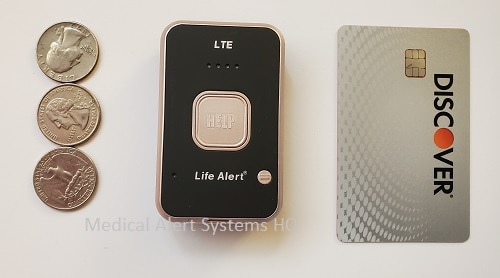
We measured its dimensions and weight; it’s approximately 2.80 inches (Length) by 1.73 inches (Width) by 0.74 inches (Depth) and 2.3 oz in weight. The Life Alert Help LTE pendant is small enough to be worn with a lanyard, belt-clip, carried in a bag or shirt pocket.
If you are active and are on-the-go quite a bit, it’s a good idea to include Life Alert’s GPS Help in your package. Compared to Life Alert’s in-home transmitter button (0.9 oz), the mobile help pendant is bulkier and heavier, but that’s to be expected as it houses a speaker and microphone.
Size Comparison with other GPS Help Buttons
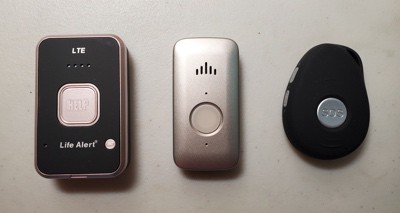
The Life Alert mobile help pendant sizing and weight is being outdone by similar newer and lighter mobile help pendants from rival companies. The Life Alert pendant weighs 2.3 oz, compared to LifeStation’s Sidekick 2021 at 1.6 oz and Mini Guardian at 1.3 oz.
Long Battery Life
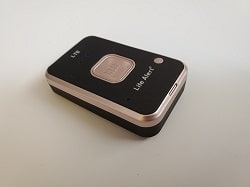
According to Life Alert, their mobile help pendant will work for up to 10 years and does not require any recharging. This medical alert device has a convenient check battery button that will run a battery test and then announce the battery level status.
We are really impressed with it’s long battery life, it’s the longest we’ve come across in the medical alert industry for a mobile GPS alert device. That makes it much easier to use on an ongoing basis.
In contrast, most mobile medical alert pendants have battery power that lasts for 3 to 5 days, so they require frequent recharging. The shorter battery life is due in part to the mobile pendant’s GPS remaining active in the background. That allows the device location to be available to the monitoring center even if the customer is unable to push their button.
GPS Function
The Life Alert mobile Help LTE pendant (920) includes GPS. The pendant uses GPS technology to provide an approximate location. The way the GPS works with Life Alert is different from other similar products in the marketplace.
The ideal scenario is for a Life Alert customer to be able to push their mobile Help button, speak with a dispatcher, and verbally confirm their location if needed. According to a representative we spoke with, the GPS information provided is for a general location, rather than a specific point on the map.
Also, GPS locations data is not automatically transmitted to the call center. Once you are on an alert call with a dispatcher, you are expected to push on the Help button to send refreshed GPS data.
The advantage of this is that the Life Alert mobile button takes less battery power and saves subscribers the hassle of having to frequently recharge the device. The disadvantage is that you cannot share your button location with others in cases where you are unable to push your button.
For example, if Mom has been out for a longer than usual time and we can’t get her on the phone, it can be worrisome. If we have a location, someone can do a check before it’s too late.
Not Waterproof
The Life Alert mobile GPS device is not waterproof and should not be worn while showering. We’ve verified this with Life Alert’s representatives. We also reviewed the pendant device‘s documentation and found no test results or ratings related to water-resistance.
To Life Alert’s credit, their device appears hardy and well-made to the naked eye, complete with a tightly sealed casing. Regardless, it’s best to keep this mobile medical alert device dry at all times.
Cell Phone App
In the past, Life Alert offered customers a smartphone app that will connect them to the company’s emergency dispatch center. However, this service is no longer offered to new customers.
Like Life Alert, most medical alert companies in the industry do not offer this feature; but if you are curious, LifeFone is one exception that does. For customers who have forgotten to bring their mobile medical alert devices with them, a cell phone app could offer a backup lifeline.
Monitoring Center Service
Life Alert runs their own UL and The Monitoring Association TMA Five-Diamond certified call monitoring center that provides service 24 hours a day, 7 days a week. They have over 40 years of experience in handling personal emergency response calls.
Many customers have said they were relieved and comforted that their Life Alert dispatcher got them the emergency help they needed. Some customers found it reassuring that their dispatcher could stay on the line with them until help arrived. Life Alert’s website presents over 42,000 testimonials from satisfied customers who needed emergency help.
Their proven monitoring service track record is one of Life Alert’s most attractive points. People may balk have being tied to a 3-year contract, but Life Alert’s representatives are always quick to point out they are “the only company that proves it saves a life from a catastrophe every 11 minutes.”
Backup Arrangements Unclear
Some people may be concerned about Life Alert’s backup monitoring arrangements. In case there is an outage in their main monitoring center, top-tier services would typically have the ability to switch to a backup call center based in another location. The best services are able to do this seamlessly through a duplicated and redundant center(s) (example).
Life Alert, however, is silent on their backup monitoring approach on their website. The representatives we spoke with were unable to confirm on a backup call center. Given Life Alert’s emphasis on the efficacy of their monitoring service, it would be fitting and reassuring if they could clarify more on their backup monitoring solutions.
Other High Quality Monitoring Services
As a comparison, there are other medical alert systems companies that offer equally reliable, high quality, monitoring services (Comparison Chart). This is based on these other call centers having the same certification standards: UL and TMA Five-Diamond certification standards. With most companies, you will also be able to check out testimonials from satisfied customers on their website.
Some companies have the capacity to operate their in-home monitoring centers (eg. LifeStation). Others contract with companies that offer US-based monitoring services that meet high certification standards like being UL listed and TMA 5-Diamond certified (eg. Medical Guardian).
In-Person Installation
If there are local Life Alert installers in your area, the company can arrange for them to do a professional on-site installation. This can be helpful for the elderly and other customers who prefer to receive in-person assistance.
If the company is unable to accommodate a professional on-site installation, they will send a pre-programmed package out to customers for self-installation. Self-installation of medical alert systems is typically very easy and fast.
Whichever way installation is done, the start-up fees are the same.
3-Year Contract
Life Alert requires a 3-year or 36-month contract for their services. Customers can pay for their services month-to-month or annually, but they must complete a three-year term.
Life Alert allows for cancellations under very stringent conditions, such as upon the death of a customer, or with official documentation when their customer moves to a skilled nursing facility. These terms are spelled out in the contract, so be sure to read it carefully before you sign.
Some customers have found the 36-month term to be difficult to carry through, despite their best intentions at the beginning. Things are always changing, and sometimes they change beyond one’s foreseeable expectations.
One customer bought their top-level package when he was experiencing a really bad health issue. His condition improved to a point he didn’t see a need to keep the service, but he was already locked into many more remaining months.
Another customer wanted to be on a fall detection system (not offered by Life Alert) on her doctor’s advice. Life Alert did not offer that service, and she had difficulty leaving due to the contract.
This contract requirement and the ensuing grievances have even become the subject of a New York state government action against the company (more below).
Still, others consider a 36-month contract manageable. If you aren’t expecting many changes to come up, it may not matter as much whether you are on a multi-year contract or not.
Times have changed within the industry when it comes to contract terms. Almost any top-tier medical alert systems company will allow customers to cancel at any time (review more companies).
Pricing Comparison
Besides the contract lock-in, Life Alert pricing also tends to be higher. Their entry-level in-home package is $50/mo, but they usually ask that customers start at a higher level plan (that includes a shower or mobile help) $69/month and up.
In general, Life Alert’s cost is around $20 to $30/mo higher than the average medical alert systems packages pricing from other companies. See medical alert cost chart. If fact, you can get a basic no-frills medical alert system for $20 to $30 a month from the best medical alert companies in the industry (see reviews).
In addition, Life Alert charges an additional $95 to $198 in start-up fees to cover items like shipping, programming, installation, and activation.
In comparison, companies in the industry typically charge $50 or less for shipping and activation, and nothing for self-installation. Usually, there will be no additional equipment costs, but some companies require that you purchase their mobile device out-right. The mobile device could add another $50 to $150 to your start-up fee, but the total is usually still less than what Life Alert charges.
Complaints
The majority of Life Alert complaints have not been about the quality of their service but difficulties in dealing with the 36-month contract obligation and cancellations.
In Mar 2021, the New York Attorney General’s office alleged that consumers were “locked in illegal contracts” by Life Alert under the state’s law and negotiated a settlement with the company. The settlement agreement highlighted customer difficulties in canceling. Some customers said they had difficulties canceling even after their initial three-year contract ended.
The NY Attorney General’s office announced a settlement with Life Alert that provided for early contract cancellations and refunds for New York state customers.
The incident affected their BBB rating briefly, but they have now returned to an A+ BBB rating. In the last three years (as of Oct 4, 2021), Life Alert had 168 BBB complaints, many related to contract obligations and cancellations. If this is an area of concern before purchase, you can read up on case details and how Life Alert responded to complaints on the BBB website.
Reviewing case details, it appeared that some customers might not have understood that they signed up for a 36-month contract. Some understood what they signed up for but found that their circumstances have changed. They wanted out but they were under already under contract.
Comparison with other Medical Alert Companies
Life Alert is an industry leader with quality medical alert systems and monitoring service, backed by decades of industry experience since 1987. In the past 10 to 15 years, however, there has been lots of industry changes brought about by active competition and new medical alert product developments.
Medical alert pricing, products, and contract terms have become more consumer-friendly than ever. Life Alert’s business approach hasn’t moved as dramatically to keep in-step. Let’s recap on some of the differences:
- Having a 3-year contract, while other companies will not tie you down.
- Higher prices and start-up fees than other companies.
- No text-to-locate or location sharing functionality with their mobile GPS button.
- Lacks online account management and caregiver app features.
- Dated product design and features. Heavier GPS device and no fall detection pendant available.
- Lack of info about their products and pricing on their website, while there is an industry trend towards more information transparency online.
Despite these differences, Life Alert compares sufficiently when it comes to product and service quality. It owns and operates its certified monitoring dispatch center and demonstrates a proven track record. That said, they are not the only company with accredited monitoring. The best medical alert systems companies adhere to similarly high professional standards as well.
We also applaud Life Alert for providing their elderly and other customers with strong and helpful system features; such as a mobile GPS device with a whopping up-to-10-year battery life, and a shower (or hallway) button that extends voice coverage within the home.
If you are looking for more advanced products and enhancements, some things Life Alert hasn’t touched upon include: medical alert smartwatches, eg. Bay Alarm Medical SOS Smartwatch; and caregiver text messaging and GPS location sharing, which the LifeFone VIPx provides.
In Short
Life Alert is an experienced medical alert systems provider with a proven track record. They offer quality equipment and monitoring. The main downsides lay in being bound to a 3-year contract and paying higher prices. Once you sign-up, you are bound by contract to continue on. If you can easily meet these obligations, and you like their service and special features, then it could be worthwhile to choose Life Alert.
As much as Life Alert reiterates that they are the only company that can deliver reliable monitoring services, there are other legitimate and quality companies in the medical alert systems industry. One example is LifeStation, an established company complete with its own US-based in-house monitoring service, and recognized by trusted healthcare organizations.
To compare Life Alert with other medical alert companies, check out the Compare Medical Alert Systems chart or our reviews section here.
Help Me Choose
If you need additional assistance selecting a good medical alert system, you can contact us here.
While every effort has been made to ensure the accuracy of the information contained in this review, the information is supplied without warranties of any kind. We advise all readers to do careful due diligence before purchasing. Take time to visit the company’s website or speak with their representatives.
Submit my Life Alert experience
Thank you for being our reader. Your opinion matters.
- Bay Alarm Medical In-Home Cellular Response Speed 46% Faster in 2023 - July 5, 2023
- Medical Alert Systems For Landlines - November 20, 2022
- The Truth About Long-Range Medical Alert Systems - May 1, 2022
In a hurry? Leave us your email, we’ll follow-up with the best tips.


